Dr Anil Kumar Maini is former director, Laser Science and Technology Centre, a premier laser and optoelectronics research and development laboratory of Defence Research and Development Organisation of Ministry of Defence
Nakul Maini is currently pursuing Masters at University of Bristol, UK. He was working as a technical editor with Wiley India Pvt Ltd
Infra-red-guided [(IR)-guided)] weapons are no less important than laser-guided munitions
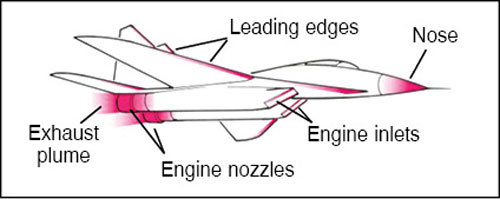
considering their usage in tactical warfare. While laser-guided munitions are predominantly used in air-to-surface and surface-to-surface roles, IR-guided weapons are largely surface-to-air man-portable air defence systems (MANPADSs) and air-to-air missiles. The IR-guided air-to-air missile has been a feature of the fighter armament since 1950’s and is likely to remain a key weapon for decades to come.
While laser and radar-guided weapons use semi-active or active homing for guidance, and therefore need an external laser source or radar for the purpose, IR-guided weapons make use of passive homing guidance in which the weapon homes on to the IR signatures due to hot areas of the target. For this reason, these are popularly known as heat-seeking weapons. Of course, for the weapon to be reliable, the guidance system processor has to perform the complex task of detecting and identifying the genuine signal in the presence of noise produced by unwanted IR emissions from the background due to reflection of solar radiation from the Earth’s surface, clouds and mountains, and IR countermeasures such as chaff and flares deployed by the target.
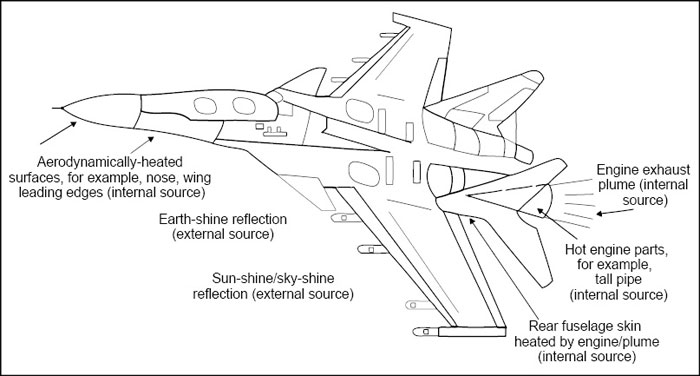
Initial development of IR-guided (or heat-seeking) missiles began in late 1950’s. AIM-4 Falcons and AIM-9 Sidewinders are important air-to-air heat-seeking missiles of that time. These weapons were not very successful, initially, due to certain issues that were mainly related to reliability. Modern IR-guided missiles are a vast improvement over the ones developed in yesteryears. These not only have increased operational ranges and hit accuracy, these are far less vulnerable to countermeasures and are capable of discriminating the intended target from passive and active countermeasures.
IR homing guidance
There are two broad categories of IR-guided weapons, namely, those employing non-
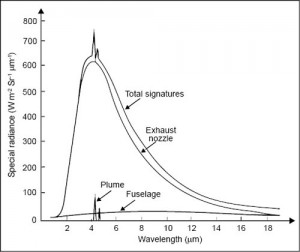
imaging-type IR-seeker heads and those employing imaging infra-red (IIR) seekers. Non-IIR-guided missiles home on to IR signatures produced by hot areas of the target. Fig. 1 shows hot spots on the target aircraft as seen by the seeker head of an IR-guided missile.
Fig. 2 shows different sources of IR signatures of the aircraft. The IR sensor used in this case is a single detector. In the case of IIR seekers, it is an imaging IR sensor, which is a focal plane array of IR/UV detectors. Imaging sensor array sees in IR in a manner similar to the
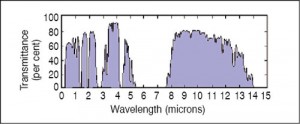
atmosphere
functioning of a CCD sensor in a webcam or a digital camera.
IIR sensor output requires much more complex signal processing. In addition to being more resistant to IR countermeasures, such as flares and decoys, imaging seekers are also less likely to be fooled into locking onto the sun, another common trick for avoiding heat-seeking
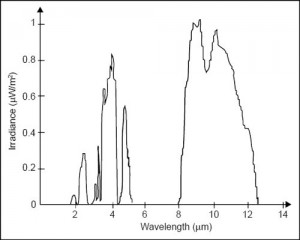
missiles. By using advanced image processing techniques, the target shape can be used to find its most vulnerable part. This information can then be used to steer the weapon towards the target.
Non-IIR-guided missiles make use of IR emission corresponding to thermal signatures of the exhaust and the mainframe of the target aircraft to home on it. Emission in 3-5 and 8-12 micron bands is characteristic of electromagnetic emission from jet exhaust and mainframe of the aircraft. Fig. 3 shows the spectral profile of IR emission from different parts of a typical target aircraft. Spectral content of IR emission as received by a seeker head is the superposition of spectral emission of the aircraft on the transmission characteristics of the atmosphere (Fig. 4).
Fig. 5 shows a typical IR-emission spectrum that would be seen by the non-imaging seeker head. This wavelength signature is judiciously used in guidance of air-to-air and surface-to-air IR-guided missiles.
Modern IR seekers also operate in the 8-12 micrometre wavelength range, which is absorbed least by the atmosphere. Such seekers are called two-colour systems. Two-colour seekers are harder to defeat with countermeasures such as flares and jammers.






